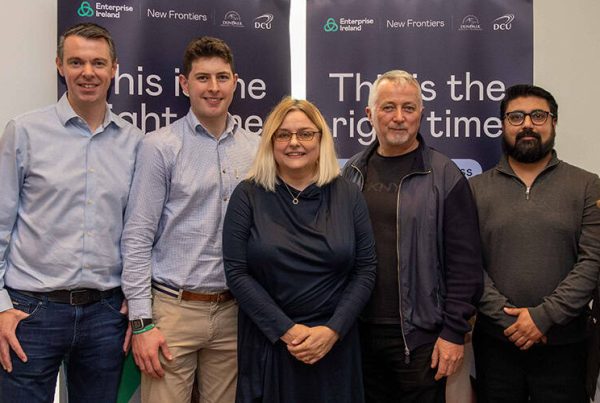
If you are unsure about what product-market fit is, ask yourself are customers banging down the door? Instead of manufacturing demand for a product or service and relying on the hard sell, product-market fit is when you have found a sweet spot in the market and customers’ needs mirror the unique value you offer.
A Qualified Executive Coach and regular Enterprise Ireland and New Frontiers trainer, Emer O’Donnell has spent 15 years helping companies to locate their sweet spot and grow. I sat down with her to find out more about this business strategy which turns build it and they will come on its head and puts customer needs in the driving seat.

Let’s start off with the obvious question, how do you define the product-market fit strategy?
One of the participants at the Founder’s Forum summed it up beautifully, way better than I could – customers are banging down the door for your stuff. Two authors have written a lot about this, Brant Cooper and Patrick Vlaskovits. Their definition of product-market fit is as follows:
Product-market fit, the match between product and market segment that results in high growth or high demand. So many customers are demanding your product that a clear market signal has been sent saying your product is needed.
Brant Cooper & Patrick Vlaskovits
Is there any way to measure it?
There are a couple of people who’ve written extensively about product-market fit in the last five to 10 years, and they’ve come up with mathematical ways of measuring it. I think those are really helpful for start-ups to look at because it takes you a little bit away from the kind of “art” or “voodoo” of am I there or am I not? and instead provides something factual for you to measure.
So, the first one of those is from Sean Ellis. Sean was the original growth hacker or marketeer behind the initial viral growth of Dropbox. Sean’s suggestion for measuring product-market fit is to ask your customers a very simple question, and that question is “How would you feel if you could no longer use or buy my product?” You give customers optional answers such as wouldn’t care, would care a bit, would be disappointed and would be very disappointed. You obviously need a reasonably sized sample to do this, but Sean’s view is that if more than 40% of the people say that they would be very disappointed if they could no longer use your product, then you probably have product-market fit!
As a trainer with the New Frontiers programme, you have a lot of hands-on experience with start-ups. What are the warning signs that they don’t have product-market fit?
If I look at the start-ups that we interact with, one of the indicators to me that a company may be at product-market fit would be when I hear them talk about the challenges in their business and they’re not talking about sales. When I hear start-ups talking about things like “My sales cycles are taking too long”, or “I’m struggling to find customers”, or “I’m missing my sales target”, that’s an indicator to me that they don’t have product-market fit.
I think one of the big mistakes that we see with start-ups that don’t have product-market fit is that they start spending money in places that they shouldn’t be spending it. There is this concept of a growth pyramid which says that at the bottom of the pyramid you should have product-market fit. You need this as a solid foundation first, and then you build everything else on top of it.
One of the most common mistakes I see start-ups making is that they hire a sales team before they have product-market fit, and then they wonder why the sales team doesn’t work out. If you’re not at product-market fit, then you either need to refocus the target audience or you need to tweak the product. But either way you need to keep your cash burn low.
To recap, product-market fit is when the market is sending out a clear signal that there is a need for whatever product or service you’re offering. Often the challenge when a company hits that point will be related to delivery, and not to sales.
Let’s say you are a start-up that does have product-market fit. What would be your advice then?
OK, on the flip side of that is say one of the companies that I am working with right now on the Founder’s Forum. They have product-market fit, and they are hesitating over expanding the team and raising money. Now they are at risk of a competitor coming in and taking the market from them. It is a balancing act. If you go too far, you run the risk that you are not building on a solid foundation; but if you go too slowly, you can miss the boat. It’s about balancing the two.
What are your key steps for achieving product-market fit?
There are three elements. The first is that they have a well-defined sweet spot or target market. They need to be very clear about who they are targeting. This can be a real challenge for a young company, because often they go too broad and go for, say, “Everyone in North America”! You need to focus down and get really clear about it.
The second one is what is the customer trying to do? What is the problem they are trying to solve or the job they are trying to get done? And knowing how you deliver in value against that and being really solid about that.
The last one is understanding why customers should choose you over the competition. You need to be clear about how you’re different from the competition. The three of these things working together is the recipe for product-market fit. If any one of them is out of whack, you are unlikely to hit product-market fit.
It’s important to remember that the answers don’t lie in your team, but in your customers. You need to be good at getting out and listening to your customers in a very open way, without assumptions. Most people will go out and look for the answers they want to hear. Instead of asking “That’s a good idea, isn’t it?” you should have a much more open set of questions to explore and get new insights. I did an exercise over the summer when I talked to 10 of our own customers, and I got some really good insights. I learned things about how our customers view us that I would never have guessed. But it’s all in the way you ask the questions.
If you’d like more insights from Emer, sign up for the monthly email sent out by her company, Select Strategies, examining the issues which affect growth in many companies.
About the author

Scarlet Bierman
Scarlet Bierman is a content consultant, commissioned by Enterprise Ireland to fulfil the role of Editor of the New Frontiers website. She is an expert in designing and executing ethical marketing strategies and passionate about helping businesses to develop a quality online presence.
Recent articles

Founder Perspectives: Lessons From Building Businesses In Sustainability

Tech Startups In The Age Of AI: Alumnus Paul Savage On Speed, Quality & Risk

Fourteen Startup Founders Graduate From Phase 2 Of New Frontiers In Tallaght

Eleven Founders Graduate From New Frontiers In The Border Mid-East Region

Laying The Right Groundwork Helps Startups Prepare For Export Success

Startup In Dublin: Learn More About New Frontiers On TU Dublin’s Grangegorman Campus

Michael Furey On The Success Of Ronspot: “The Most Important Thing Is Research”


